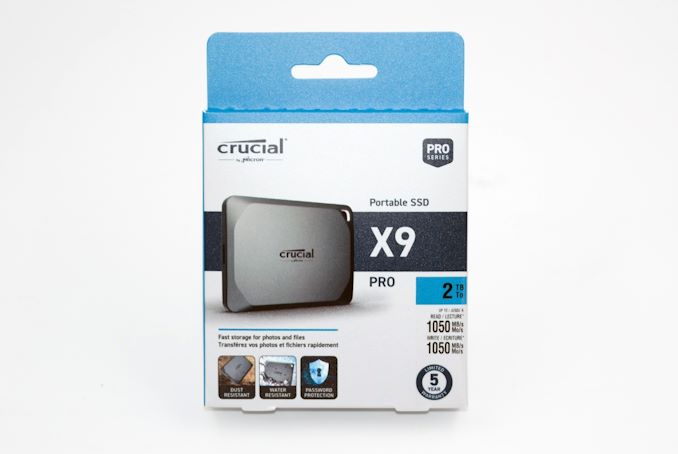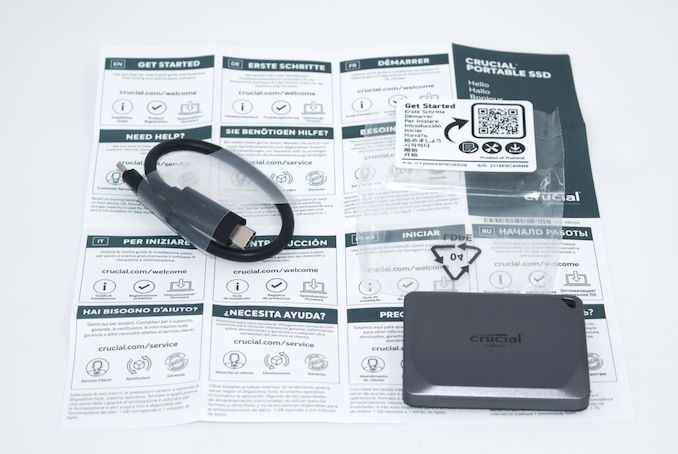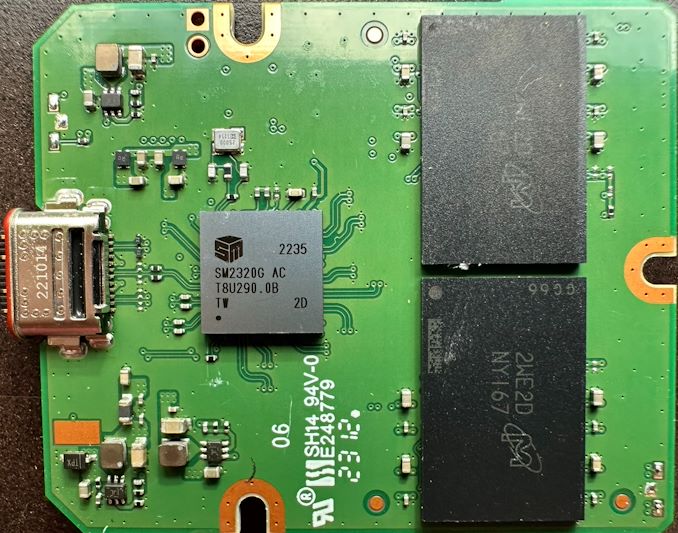Crucial X9 Pro Portable SSD Review: Micron 176L 3D NAND Delivers Record UFD Consistency
by Ganesh T S on August 18, 2023 8:00 AM EST- Posted in
- Storage
- Crucial
- Micron
- DAS
- Silicon Motion
- Type-C
- USB
- Portable SSDs

Crucial's flash-based storage lineup has had a distinctive focus on internal SSDs, with a range of options catering to both mainstream and power users. On the portable SSD front, the company's X6 and X8 Portable SSDs have been attractive budget options for the mainstream consumers. However, these drives use QLC and are not entirely suitable for power users (such as content creators) who require writing vast amounts of data as quickly as possible.
The company introduced two new products in the PSSD category in July 2023 - the USB 3.2 Gen 2 X9 Pro, and the USB 3.2 Gen 2x2 X10 Pro. These 1 GBps and 2 GBps-class drives come with a Type-C port and a Type-C to Type-C cable (Type-A adapter sold separately). The performance specifications of these two products indicate suitability for power users - for the first time, the company is quoting write speeds for their PSSDs in the marketing material.
Crucial sampled the 2TB version of the X9 Pro for review, and we put it through our rigorous direct-attached test suite. This review takes a detailed look at the performance and value proposition of the PSSD, with a particular focus on how it stacks up against the existing players in the segment.
Introduction and Product Impressions
Flash technology has seen rapid advancements in recent years (such as the development of 3D NAND and improvements in TLC reliability). These have been accompanied by the appearance of faster host interfaces for external devices. Together, they have contributed to bus-powered direct-attached storage devices growing in both storage capacity and speeds. The Type-C standard has also achieved widespread acceptance in the consumer market. Protocols such as USB 3.2 Gen 2x2 / USB4 and Thunderbolt riding on top of the Type-C connector have enabled the introduction of palm-sized flash-based storage devices capable of delivering 2GBps+ speeds. The 10 Gbps USB 3.2 Gen 2 interface has become ubiquitous in moder systems and has emerged as the sweet spot for mainstream users.
One of the primary challenges with high-speed storage devices is the thermal aspect. Bridge-based solutions with multiple protocol conversion chips tend to dissipate more power due to the additional components. High-performance portable SSDs in the past have had no option but to use them - first, with SATA bridges, and then with NVMe bridges. The introduction of native UFD controllers capable of hitting 10 Gbps and 20 Gbps from Phison and Silicon Motion has opened up yet another option in this category. The Crucial X6, equipped with the Phison U17, was reviewed in August 2021 and was one of the first retail products to surpass the SATA speeds barrier by hitting 800 MBps speeds without using a NVMe bridge. Around the same time, Silicon Motion's SM2320 powered the Kingston XS2000 to 20 Gbps speeds without a bridge in the middle.
Products based on Silicon Motion's SM2320 have gained a lot of consumer mindshare because they have typically been able to hit the interface speed limits for sequential accesses in both the 10 Gbps and 20 Gbps categories. However, consistency was an issue as the initial wave of products used Micron's 96L 3D TLC or BiCS 4 / BiCS 5 (up to 112L) 3D TLC NAND. The introduction of faster flash has since allowed portable SSDs (PSSDs) based on the native UFD controllers to hit higher speeds and maintain them even in direct-to-TLC scenarios.
The X9 Pro we are looking at in this review is a 38g 65mm x 50mm USB 3.2 Gen 2 PSSD made of anodized aluminum. It includes a lanyard hole (with the LED near the hole, rather than near the Type-C port) and a rubberized soft-touch base for protection against bumps. The sides are slightly recessed for better traction during handling. It is IP55 rated, and drop-proof up to 7.5'. The packaging is minimal - a short USB 3.2 Gen 2 Type-C to Type-C cable and a user guide in addition to the main unit.
The Silicon Motion SM2320 native controller and Micron's 176L 3D TLC NAND packages are seen in the board. Each package appears to have eight 1 Tbit dies.
CrystalDiskInfo provides a quick overview of the capabilities of the internal storage device. TRIM and NCQ are not seen in the features list, though we have seen those available in other PSSDs based on the Silicon Motion SM2320. Crucial indicated that TRIM support will be enabled in the next firmware update. We will see in the next section that native command queuing is active in the PSSD, and all S.M.A.R.T features such as temperature read outs worked well.
| S.M.A.R.T Passthrough - CrystalDiskInfo | |
 |
 |
The table below presents a comparative view of the specifications of the different 2TB 1 GBps-class PSSDs presented in this review.
| Comparative Direct-Attached Storage Devices Configuration | ||
| Aspect | ||
| Downstream Port | Native Flash | 1x PCIe 3.0 x4 (M.2 NVMe) |
| Upstream Port | USB 3.2 Gen 2 Type-C (Female) | USB 3.2 Gen 2 Type-C (Male) |
| Bridge Chip | Silicon Motion SM2320 | ASMedia ASM2362? |
| Power | Bus Powered | Bus Powered |
| Use Case | 1GBps-class, sturdy palm-sized high-performance portable SSD with a Type-C interface | 1GBps-class, IP67-rated rugged portable SSD for on-the-go content capture workflows |
| Physical Dimensions | 65 mm x 50 mm x 10 mm | 95 mm x 50 mm x 15 mm |
| Weight | 38 grams | 91 grams |
| Cable | 22 cm USB 3.2 Gen 2 Type-C (male) to Type-C (male) | 49 cm USB 3.2 Gen 2 Type-C to Type-C 48 cm USB 3.2 Gen 2 Type-C to Type-A |
| S.M.A.R.T Passthrough | Yes | Yes |
| UASP Support | Yes | Yes |
| TRIM Passthrough | Yes | Yes |
| Hardware Encryption | Yes | Yes (256-bit AES, only via SanDisk Secure App) |
| Evaluated Storage | Micron B47R 176L 3D TLC | SanDisk BiCS 4 96L 3D TLC |
| Price | $130 | USD 360 |
| Review Link | Crucial X9 Pro 2TB Review | SanDisk Professional G-DRIVE SSD 2TB Review |
Prior to looking at the benchmark numbers, power consumption, and thermal solution effectiveness, a description of the testbed setup and evaluation methodology is provided.
Testbed Setup and Evaluation Methodology
Direct-attached storage devices (including thumb drives) are evaluated using the Quartz Canyon NUC (essentially, the Xeon / ECC version of the Ghost Canyon NUC) configured with 2x 16GB DDR4-2667 ECC SODIMMs and a PCIe 3.0 x4 NVMe SSD - the IM2P33E8 1TB from ADATA.
The most attractive aspect of the Quartz Canyon NUC is the presence of two PCIe slots (electrically, x16 and x4) for add-in cards. In the absence of a discrete GPU - for which there is no need in a DAS testbed - both slots are available. In fact, we also added a spare SanDisk Extreme PRO M.2 NVMe SSD to the CPU direct-attached M.2 22110 slot in the baseboard in order to avoid DMI bottlenecks when evaluating Thunderbolt 3 devices. This still allows for two add-in cards operating at x8 (x16 electrical) and x4 (x4 electrical). Since the Quartz Canyon NUC doesn't have a native USB 3.2 Gen 2x2 port, Silverstone's SST-ECU06 add-in card was installed in the x4 slot. All non-Thunderbolt devices are tested using the Type-C port enabled by the SST-ECU06.
The specifications of the testbed are summarized in the table below:
| The 2021 AnandTech DAS Testbed Configuration | |
| System | Intel Quartz Canyon NUC9vXQNX |
| CPU | Intel Xeon E-2286M |
| Memory | ADATA Industrial AD4B3200716G22 32 GB (2x 16GB) DDR4-3200 ECC @ 22-22-22-52 |
| OS Drive | ADATA Industrial IM2P33E8 NVMe 1TB |
| Secondary Drive | SanDisk Extreme PRO M.2 NVMe 3D SSD 1TB |
| Add-on Card | SilverStone Tek SST-ECU06 USB 3.2 Gen 2x2 Type-C Host |
| OS | Windows 10 Enterprise x64 (21H1) |
| Thanks to ADATA, Intel, and SilverStone Tek for the build components | |
The testbed hardware is only one segment of the evaluation. Over the last few years, the typical direct-attached storage workloads for memory cards have also evolved. High bit-rate 4K videos at 60fps have become quite common, and 8K videos are starting to make an appearance. Game install sizes have also grown steadily even in portable game consoles, thanks to high resolution textures and artwork. Keeping these in mind, our evaluation scheme for portable SSDs and UFDs involves multiple workloads which are described in detail in the corresponding sections.
- Synthetic workloads using CrystalDiskMark and ATTO
- Real-world access traces using PCMark 10's storage benchmark
- Custom robocopy workloads reflective of typical DAS usage
- Sequential write stress test
In the next couple of sections, we have an overview of the performance of the two PNY PSSDs in these benchmarks. Prior to providing concluding remarks, we have some observations on the drives' power consumption numbers and thermal solution also.













18 Comments
View All Comments
ceisserer - Friday, August 18, 2023 - link
Too bad those devices are soo clumsy - that SM2320 together with one NAND chip in a tiny package would result in an excellent small portable OS drive. Of course there would be thermal throttling, however that plastic case that crucial drive is shipped with doesn't seem to do a lot for thermals either...ganeshts - Friday, August 18, 2023 - link
The casing of the X9 Pro is anodized aluminum. Thermals are great (refer graphs in the final section). Can't expect anything better for this performance class given the constraints of the SM2320 (DRAM-less / native UFD)meacupla - Friday, August 18, 2023 - link
62c after an extended run is pretty good.If it's hitting 80c, then I would start to worry.
dqniel - Friday, August 18, 2023 - link
Are we reading the same review? The thermals look good. Performance doesn't seem to degrade in their extended tests.nfriedly - Friday, August 18, 2023 - link
I recently got a Transcend ESD310 and I friggin love it.It gets a little warm, and it's not the fastest *SSD*, but it looks like a regular little USB flash drive, and it's performance blows away anything else that's a comparable size.
Also, it has a USB-A connector on one end and a USB-C connector on the other, so I can plug it into basically any computer (or recent Android device).
MiltzMan - Monday, August 21, 2023 - link
On a MacBook Pro 16 inch M1Pro this drive performs exactly like the X8. The sustained writes are about 300mb/s which is awful. The drive only performs well in benchmarks and it’s an upgrade to the X8. I’m extremely disappointed.ganeshts - Monday, August 21, 2023 - link
It performs great in regular usage. Most of our 'benchmarks' are real-world use-cases dealing with regular file transfers.What file system is your X9 Pro formatted in? We tested with exFAT, and it should perform similarly in all OSes.
You should report your findings to Crucial support. Sustained write of 300 MBps for sequential workloads (large-sized file transfers) is not expected from the X9 Pro. Of course, if you are transferring lots of small-sized files (say 4KB to 64KB in size), then all bets are off.
MiltzMan - Monday, August 21, 2023 - link
I’m using the 4TB version formatted to APFS. I’m transferring folders with lots of raw camera files. Files range from 20 to 60MB in size and the folders are up to 350GB. I also find it odd that the Crucial software doesn’t support the X9 Pro drive yet. You think my drive is defective? If so I will return it.ganeshts - Tuesday, August 22, 2023 - link
20 - 60 MB is pretty large. You should be getting 600 MBps+ for those types of file sizes. I would say that you need to take it up with Crucial support and follow their advice on the return. I assume they will ask you to do some additional tests before branding the drive as defective. Since I don't have any experience with Apple systems, I am not sure where exactly the bottleneck is creeping in, but the support team probably will have more inputs.Luke Ottrey - Wednesday, August 23, 2023 - link
Hi MiltzMan and Ganesh - Luke from Crucial/Micron here.I run a Macbook Air M1 myself; and while I am not in a position to really make authoritative comments on how Apple resources their USB/Thunderbolt ports; I can confirm that I personally have seen on my machine some less-than-USB-bus speeds on my M1 Air. Unfortunately I don't have a large enough internal SSD to do a similar comparison to your workload of 350GB large files; but just now I copied three folders each with 10GB of various linux distribution downloads, PSD's, zip files etc and achieved around 32.6GB transferred in 44 seconds; around 740MB/s on an APFS formatted X9 Pro.
300MB/s is abnormal; but as Ganesh alludes to, small files and filesystem overheads often become a large part. Please forgive the question; but are you sure there are no small files (hidden files, etc) that are being copied across that could be contributing to filesystem overhead?